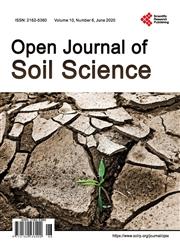Comparing Two Methods for Measuring Soil Bulk Density and Moisture Content
引用次数: 8
Abstract
Soil bulk density and moisture content are dynamic properties that vary with changes in soil and field conditions and have many agricultural, hydrological and environmental implications. The main objective of this study was to compare between a soil core sampling method (core) and the CPN MC-3 EliteTM nuclear gauge method (radiation) for measuring bulk density (ρB) and volumetric moisture content (θv) in a clay loam soil. Soil ρB and θv measurements were determined using the core and radiation methods at 0 - 10 and 10 - 20 cm soil depths. The mean values of soil ρB obtained using the core method (1.454, 1.492 g·cm−3) were greater than those obtained using the radiation method (1.343, 1.476 g·cm−3) at the 0 - 10 and 10 - 20 cm depths, respectively. Mean ρB and θv values averaged across both depths (referred to as the 0 - 20 cm depth) measured by the core method were 4.47% and 22.74% greater, respectively, than those obtained by the radiation method. The coefficients of variation (CV) of soil ρB values measured by the core method were lower than the CV values of those measured by the radiation method at both depths; however, the CV’s of ρB values for both methods were larger at the 0 - 10 cm depth than those measured at the 10 - 20 cm depth. Similarly, the CV values of soil θv values measured by the core method were lower than the CV values of those measured by the radiation method at both depths. There were significant differences between two methods in terms of ρB and θv, with the core method generating greater values than the radiation method at the 0 - 20 cm depth. These discrepancies between the two methods could have resulted from soil compaction and soil disturbance caused by the core and radiation techniques, respectively, as well as by other sources of error. Nevertheless, the core sampling method is considered the most common one for measuring ρB for many agricultural, hydrological and environmental studies in most soils.测定土壤容重和含水量的两种方法的比较
土壤容重和含水量是随土壤和田间条件变化而变化的动态特性,具有许多农业、水文和环境影响。本研究的主要目的是比较土壤岩芯取样法(岩芯)和CPN MC-3 EliteTM核子计法(辐射)在粘壤土中测量体积密度(ρB)和体积含水量(θv)。在土壤深度0-10和10-20 cm处,使用岩心法和辐射法测定土壤ρB和θv。在0-10和10-20 cm深度处,使用芯法获得的土壤ρB的平均值(1.454,1.492 g·cm−3)分别大于使用辐射法获得的ρB的均值(1.343,1.476 g·cm–3)。岩心法测得的两个深度(称为0-20 cm深度)的平均ρB和θv值分别比辐射法测得值高4.47%和22.74%。在两个深度,岩芯法测得的土壤ρB值的变异系数(CV)均低于辐射法测得土壤ρB的变异系数;然而,两种方法的ρB值在0-10 cm深度处的CV均大于在10-20 cm深度处测得的CV。类似地,在两个深度,通过岩芯法测量的土壤θv值的CV值都低于通过辐射法测量的CV值。两种方法在ρB和θv方面存在显著差异,在0-20 cm深度处,岩心法产生的值大于辐射法。这两种方法之间的这些差异可能是由于岩心和辐射技术分别造成的土壤压实和土壤扰动,以及其他误差来源造成的。然而,在大多数土壤的许多农业、水文和环境研究中,岩芯取样法被认为是测量ρB最常见的方法。
本文章由计算机程序翻译,如有差异,请以英文原文为准。
求助全文
约1分钟内获得全文
求助全文

 求助内容:
求助内容: 应助结果提醒方式:
应助结果提醒方式:


